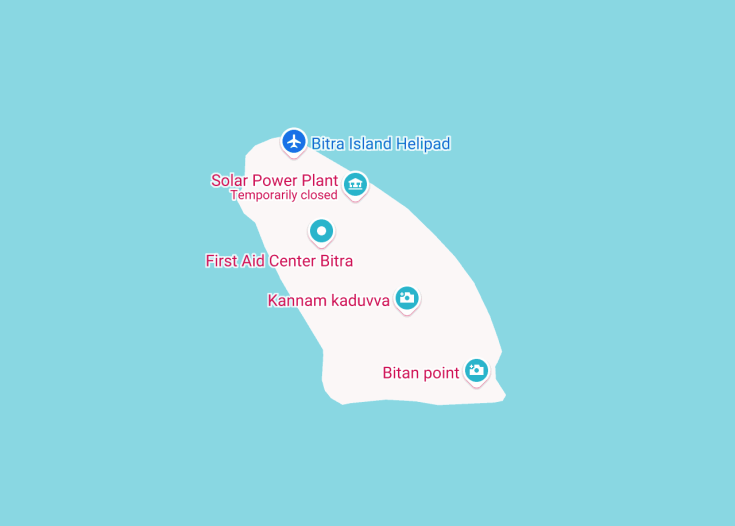Bitra, one of the smallest inhabited islands in the Lakshadweep archipelago of India, offers a unique glimpse into serene island life, away from the bustling crowds of more popular destinations. Known for its vibrant coral reefs and rich marine life, Bitra is a haven for nature lovers and adventure seekers alike. The island’s limited population, primarily engaged in fishing and coconut cultivation, adds to its quaint, untouched charm. Visitors here can immerse themselves in the peaceful ambiance, enjoy stunning sunsets, and explore the unspoiled natural beauty that Bitra so gracefully preserves.
For the best experience, plan your visit during the early winter months when the weather is most favorable for exploring and the waters are calm.
Ensure to respect local customs and the natural environment. Carry essentials as the island has limited facilities, enhancing the rustic charm of your visit.
Top things to do & see in Bitra Island (Bitrā Par)
Select the following sights and activities to discover best tickets and tours available in Bitra Island (Bitrā Par).
Bitra: A Hidden Jewel in the Lakshadweep Archipelago
| Country | India |
| Time in Bitra | GMT+5:30 |
| Language spoken | Malayalam |
| Population | 271 (Census 2011) |
| Currency | Indian Rupee (₹ / INR) |
| Airports |
|
Bitra, one of the smallest of the Lakshadweep islands in India, remains largely untouched by mainstream tourism. Historically, it has been a light house base and a bird sanctuary, lending it a quaint and serene atmosphere distinct from more commercial destinations. Inhabited by a small population, Bitra’s charm lies in its simplicity and the pristine natural beauty of its surrounding coral reefs and azure waters. Explorers and nature lovers are rewarded with a rare sense of tranquility and a break from the overwhelming hustle of urban life. Despite its limited accessibility, those who make the journey meet a warm, welcoming community and diverse marine life which make the experience uniquely rewarding.
Where is Bitra?
Bitra is located in the central part of the Lakshadweep archipelago, southwest of the Kerala coast in India.
Distances:
| Route | Distance by car | Time by car |
|---|---|---|
| Kochi to Agatti, then by boat | Not applicable | Not applicable |
| Agatti to Bitra (by boat) | Approx. 170 mi | Varies |
What is Bitra famous for?
Bitra is renowned for its tranquil environment, vibrant coral reefs, and a unique status as a sanctuary for seabirds, making it a sought-after destination for conservationists and nature enthusiasts.
History
Bitra, one of the smallest inhabited islands in the Lakshadweep archipelago of India, has a unique history that dates back to ancient times. Although relatively obscure, its historical evolution offers insight into the broader socio-economic and cultural transformations within this island group.
Pre-Colonial Era (Before 16th Century)
The early history of Bitra is sparsely documented, but it’s believed that the island was visited by seafarers and settlers from nearby regions. Like other islands in Lakshadweep, Bitra was influenced by the maritime activities along the Malabar coast, facilitating cultural exchange and trade. Early inhabitants largely engaged in fishing and coconut cultivation, which formed the basis of their subsistence economy.
Colonial Era (16th – 20th Century)
With the arrival of Portuguese explorers in the 16th century, followed by British colonial rule, Bitra experienced significant changes. The British administration implemented governance structures and integrated the island into the maritime trade networks. During this period, Bitra served as a strategic location for colonial powers to monitor sea routes and protect their merchant ships from pirates. The British also conducted surveys and mappings, which are some of the earliest formal recordings of the island’s geographical features.
Post-Independence Era (1947 – Present)
Following India’s independence in 1947, Bitra became part of the Union Territory of Lakshadweep in 1956. Since then, the government has undertaken various developmental initiatives aimed at improving the living standards of the local population. Infrastructure such as solar power installations and desalination plants have been introduced to ensure sustainable living conditions. Despite its small size and limited resources, Bitra has maintained its cultural heritage, primarily through the conservation of its flora, fauna, and marine life.
Visit Bitra
What to see and do in Bitra, India.
Despite its small size, Bitra offers a quaint escape with its pristine natural beauty and tranquil environment. Visitors can enjoy:
- Beach walks along the sandy shores, providing a serene experience amidst the backdrop of coconut palms.
- Snorkeling and diving near the coral reefs, which are part of the island’s rich marine biodiversity.
- Bird watching, as Bitra is home to various species of seabirds, providing splendid opportunities for ornithologists and nature enthusiasts.
Cultural and Seasonal Celebrations
Although Bitra might not host large scale events due to its small population and limited space, the community participates in local festivals and cultural events, especially during significant periods like Diwali and Eid, reflecting the island’s communal harmony and cultural richness.
Best time to visit Bitra
The ideal time to visit Bitra is between November and March when the weather is cooler and more pleasant, making it perfect for outdoor activities and exploring the island’s natural beauty.
Is Bitra worth visiting?
Bitra, while modest in size and offerings, is certainly worth a visit for those seeking an unspoiled, peaceful retreat from the bustling tourist paths. Its undisturbed beaches, vibrant coral reefs, and the warm hospitality of its residents offer an intimate glimpse into the tranquil island life away from the conventional tourist circuits.










